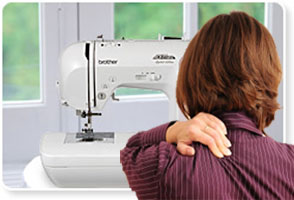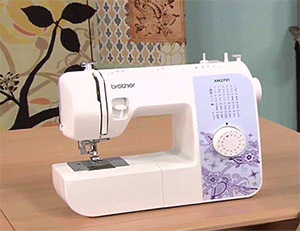Stay Comfortable, Sew Longer
A comfortable, ergonomically designed sewing space can help minimize backaches and body cramps that often occur from working in the same position for long periods of time so you can spend more time doing what you really want – Sewing!
Pain-Free Sewing Please

I enjoy sewing very much and I can spend hours in front of my sewing machine designing and crafting until I get my project exactly to my liking. Okay, call me a perfectionist, but there is nothing I enjoy more than creating something with my own hands, not to mention the pride and warmth I feel when I can display my work for everyone to see or give a handcrafted gift to a loved one. But let’s face it, sewing for long hours on end can be a pain in the neck (no pun intended!)
When I was starting out I didn’t have much room for sewing spaces so I would turn wherever I was into a sewing space – whether sitting at the kitchen table hunched over a sewing machine, sprawling out on the living room floor pinning fabric and pattern pieces together or grabbing what little spot I could find near the coffee table sharing a good movie with a pair of Fiskars pinking shears.🙂 You might say that you find ways to be resourceful when you need to. But it’s not so good on the back…or… legs… arms… neck. I think you get the picture.
Fast forward to today –I have better sewing spaces now! But every now and again I can still get that little twinge…🙁
If you are constantly feeling aches and pains after spending time in front of your sewing machine then it might be time to talk ergonomics – the ergonomics of sewing that is.
So what exactly is “Ergonomics”? It’s all about making your environment, in this case your sewing environment, as comfortable to work in as possible so that you can reduce the potential of body aches from sitting in the same position for long periods of time. Then you can spend more time doing what you really want to do: sew! Got your attention? Ok, let’s go!
A Comfortable Place to Sew
Your Sewing Table
 Let’s begin with your sewing table. This is a very important part of keeping your back as pain free as possible. First of all, the dining room table is just not the best place to be sewing. It is typically too high to sew comfortably, ergonomically speaking. If the space is too high you will have to lift your shoulders to get your arms high enough to be able to reach the sewing area. This can cause strain in the shoulders, the neck and the upper back muscles as well.
Let’s begin with your sewing table. This is a very important part of keeping your back as pain free as possible. First of all, the dining room table is just not the best place to be sewing. It is typically too high to sew comfortably, ergonomically speaking. If the space is too high you will have to lift your shoulders to get your arms high enough to be able to reach the sewing area. This can cause strain in the shoulders, the neck and the upper back muscles as well.
If the sewing area is too low, which many times is the case, you will be hunching forward to sew which places strain, again, on the neck, shoulders and back. All this is fatiguing and results in muscle pain. The most comfortable position should have your back upright against the back of your seat with your elbows consistently at right angles and your forearms parallel to the floor as you sew.
Here’s how to determine the proper height for sewing:
First sit in a comfortable, adjustable chair with your feet flat on the floor. Now adjust your seat until your knees are bent at about a 90 degree angle or so. With your elbows bent in front of you at right angles have a friend measure the distance from your elbow to the floor. This is the ideal height for your sewing table, provided that your sewing machine bed is flush with the table, such as is the case with the machines that are built into sewing cabinets . If your machine is not a built-in to a sewing table style you will have to account for the additional 3 inches for the sewing machine base. One option is to raise your seat slightly to maintain that 90 degree bend in your arms. You may also want to place something under your feet to keep them flat and your knees bent at about 90 degrees as well. Another option is just to use a lower table.
If you are up for the challenge you can build your own ergonomic sewing table that is suitable for your specific height requirements. It’s easier that you think. Below are 3 videos that explain how to do it:
How to Build a Cheap Sewing & Quilting Table #1, 2 and 3
Your Sewing Chair 
A comfortable chair that’s easy to adjust is a must: one with adjustable height as well as an adjustable backrest will provide the greatest comfort. A waterfall front edge in which the front of the seat slopes or slightly drops down helps to keep space between the chair and the back of the legs, minimizing pressure on the back of the legs as pressure can reduce blood circulation to the thighs.
A pneumatic seat, one with a little bounce, gives your back support by taking the pressure off your back. A cushioned seat helps to distribute weight so that no part body of your body is feeling the strain of all the pressure.
Proper Lighting
 Most sewing machines come with a built-in light that shines directly on the sewing area. However this is typically not enough and you will more than likely need additional lighting for the surrounding area. Don’t underestimate the importance of good lighting; insufficient lighting can cause eyestrain and possibly headaches. The ideal situation would be to choose a sewing space that has as much natural light as possible. If not then a flexible table lamp that can be positioned as you need would be the next best option. Another great option would be a light fixture that provides a magnifying glass or has one attached.
Most sewing machines come with a built-in light that shines directly on the sewing area. However this is typically not enough and you will more than likely need additional lighting for the surrounding area. Don’t underestimate the importance of good lighting; insufficient lighting can cause eyestrain and possibly headaches. The ideal situation would be to choose a sewing space that has as much natural light as possible. If not then a flexible table lamp that can be positioned as you need would be the next best option. Another great option would be a light fixture that provides a magnifying glass or has one attached.
Okay, so there you have it! Now we’re ready to sew! Let’s get to it!





